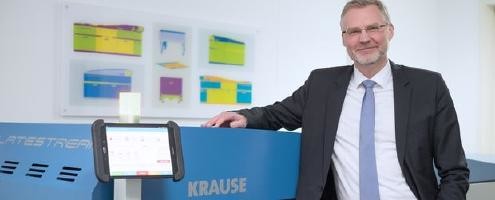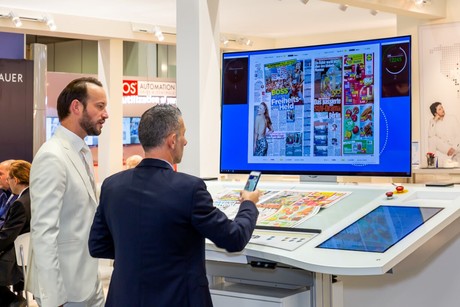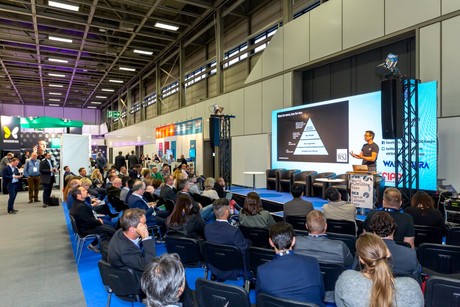Mr. Nobbenhuis, could you please briefly introduce Krause-Biagosch?
André Nobbenhuis: With pleasure. It all began in 1855 with the company`s establishment by Karl Krause. In 1929, Krause built the worldwide first step-and-repeat machine. In 1975, Jürgen Horstmann purchased our company and gradually built the Horstmann Group. Our first CTP installation followed in 1989. Now, we are a modern technology company with nearly 60 employees, of which five are apprentices. We offer total CTP solutions for newspaper and commercial printing, comprising hardware and software, including service, as well as a product portfolio ranging from the professional entry-level model to high-performance platesetters with speeds of more than 400 pph and fully automated CTP lines.
Are there any synergies between the companies of the Horstmann Group?
Nobbenhuis: Within the group, there are one IT&EDP company, two furniture-manufacturing companies and five providers of bakery technology as well as four metal construction companies. Our most important partners within the Group are the CNC company M. Mühl, with which our engineering department cooperates closely, and Krause DiMaTec, a specialist for additive manufacturing that produces special parts for us and with whom we share laser expertise. Furthermore, there is Krause Repro, a vendor of supplies and materials, in particular printing plates and developing chemicals. However, our platesetters are compatible with plates of many partners. We are selling our solutions worldwide via the strongest partners in the respective markets. In the CTP markets, the cost of consumables account for nearly 90 % – the platesetters, on the other hand, for barely a tenth.
You have 34 dealers worldwide. Does your technology differ depending on the market?
Nobbenhuis: The biggest difference lies in the plate sizes and processes, i.e. whether the plates are exposed with visible violet laser light, UV laser or thermal technology using infrared laser systems. We manufacture the optical systems and drive controllers completely on our own. This makes us independent, ensures upward and downward compatibility of our solutions and is a guarantee of consistently high quality. We do not offer low-cost solutions.
Newspaper and commercial printing are difficult markets. Do you seek diversification?
Nobbenhuis: That`s undeniable. In our traditional markets, sales are decreasing and consolidation measures are going on. Nevertheless, I see a promising long-term future in the newspaper market. Newspapers offer what digital media fail to provide: Reliable, concrete information. That makes them indispensable. We are, however, looking for additional markets. We still see potential for offset printing in the packaging and textile sector.
Your roots lie in paper technology. Which role does it play now?
Nobbenhuis: Newspaper and commercial printing are our traditional markets. Our technological focuses are, however, on photonic CTP solutions, process automation, software and electronics. In the event of a failure, our new platesetter generation can even send the fault including camera sequences from the affected unit to our customers.
So, like many machinery manufacturers, you increasingly focus on services?
Nobbenhuis: We expand our range systematically and only recently hired an experienced after-sales expert for that. In addition, we push ahead with Print 4.0. Being a CTP specialist, Krause-Biagosch concentrated on digitization very early and now expands it to the service sector: Condition monitoring to ensure that failures in our platesetters do not occur at all and, should one occur nevertheless, customers receive a precise cause analysis immediately. We also work on augmented-reality solutions for our machines that can be used by our service technicians to assist our customers all over the world in the rectification of faults. We thus wish to achieve shorter response times and significant cost reductions for our customers. In future, we want to share this knowledge with other machine manufacturers.
You just mentioned process automation.
Nobbenhuis: The emphasis is on the workflow of the customer. We take the lean manufacturing approach as a basis: Short paths, flexible intralogistics and a higher degree of automation to optimize material handling and the space requirements in the CTP sector.
Where is the CTP sector heading?
Nobbenhuis: There are some trends: “LowChem“ minimises the use of chemicals by means of violet laser sensitive printing plates; and since the plates are clean when they leave the process, maintenance requirements are reduced as well. With thermal laser plates, a complete process step is eliminated since plate development is carried out in the printing machine. In addition, we focus on usability, especially on the touch user interfaces, modelled on the smartphone. Moreover, we are working on the transfer of our know-how from fast, reliable newspaper printing to commercial printing processes. Both kinds of printing companies must increase their flexibility: Depending on the market, they can choose between maximum resolution and maximum speed with our CTP technology.
Which role does additive manufacturing play in your strategy?
Nobbenhuis: Our competences with regard to electronics, software, laser technology and fine positioning are a good basis for activities. Together with Krause DiMaTec, we develop solutions for special customer requests; cases for which there is no solution available are collected as a basis for our own engineering developments. Very soon, we will present the first Fused Deposition Modeling (FDM) systems with augmented reality assistance with the aim to ensure proper mechanical engineering quality. We manufacture the machine platform and Krause DiMaTec offers consulting as regards AM design and process parameters.
This sounds very forward-looking. How do you see Krause-Biagosch in the year 2030?
Nobbenhuis: Like before, we will develop technologies for the printing industry. Printing will still be omnipresent in 2030, then also in the form of 3D printing. As an established supplier, we will offer solutions for all printing-related processes: From process automation to software and electronics as well as photonics. Offset printing will remain our bread and butter business. Added to that, we will transfer our know-how – in the beginning via our sister companies of the Horstmann Group – to other markets as well. It will be a busy decade.
(http://www.krause.de – http://dup.vdma.org)
"We are working hard on Print 4.0 solutions"
"We are working hard on Print 4.0 solutions"
Article ID:
20653
(PresseBox) (Frankfurt, 02.02.2017) – Krause-Biagosch GmbH is leading as regards Computer-to-Plate-(CTP)-technology for newspaper and commercial printing. André Nobbenhuis has been one of the managing directors of this long-established Bielefeld-based company for a few months now. In this interview, he explains where he sees development potentials for CTP technology, how he tackles diversification issues and why he believes that printing has a future.

André Nobbenhuis.
Related Articles
-
2020-10-15 11:21
-
2020-10-08 10:36
-
2020-09-29 17:42
-
2020-09-29 17:24
-
2020-09-29 10:57




